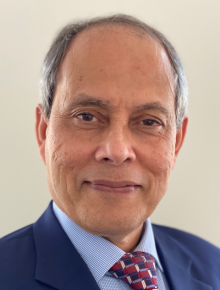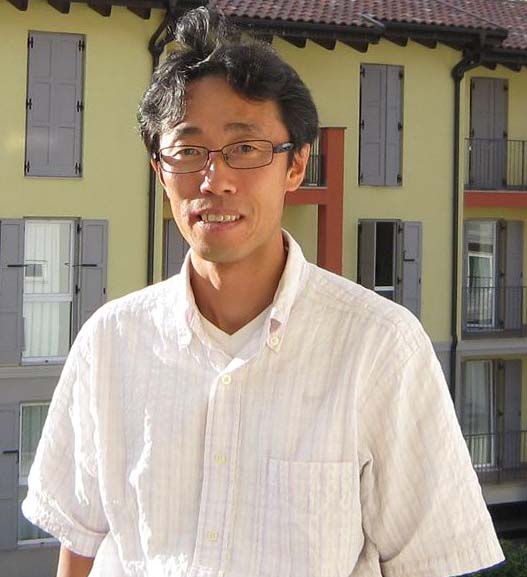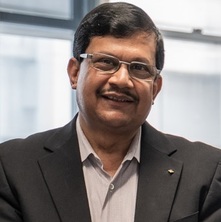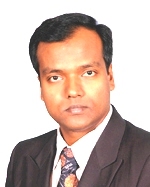

| Dr. Saifur Rahman Joseph Loring Professor Department of ECE Virginia Tech Research Center – Arlington VA 22203, United States |
 |
| Title: Global Electric Power Sector: Engaging with Environmental Issues Abstract: China, US, India, Japan and Russia are the top five countries in terms of electricity generation capacity. Between them they had a total capacity of 3,650 million kW in 2016. In terms of fuel sources for electricity coal, natural gas, hydro, nuclear, renewables and oil provided 38.3%, 22.9%, 16.3%, 10.2%, 9% and 3.3% respectively in 2017. This means almost two-thirds of the global electricity production came from fossil fuels in that year. This is reflected in about 10 billion tons of CO2 from electricity generation or about a third of the global production. However, this mix is expected to change significantly in the next 10 years. By 2030 installed power generation capacities from wind, solar PV, hydro power, nuclear and thermal are going to reach 540 GW, 420 GW, 530 GW, 160 GW and 1200 GW respectively. The top five CO2 emitting countries are: China, United States, India, Russian Federation and Japan each producing between nine and one billion metric tons of CO2 in 2016. However, CO2 is not the only concern against global warming. The Global Warming Potentials (GWP) of greenhouse gases are as follows: CO2 (1), Methane (28), Hydro fluorocarbons (138), Nitrous oxide (265), Per fluorocarbons (6,630) and Sulphur hexafluoride (23,500). So, the bottom line is: Efforts in the electric power sector to replace fossil fuel with renewables and nuclear will help. But if emission from the transportation sector continues to rise, the drop in power sector contributions will not be enough. Large scale Electric Vehicle deployment will help, but question remains – how will the EV be powered.. |
|
|
Biography: Professor Saifur Rahman is the founding director of the Advanced Research Institute at Virginia Tech, USA where he is the Joseph R. Loring professor of electrical and computer engineering. He also directs the Center for Energy and the Global Environment. He is a Life Fellow of the IEEE and an IEEE Millennium Medal winner. He was the president of the IEEE Power and Energy Society (PES) for 2018 and 2019. He was the founding editor-in-chief of the IEEE Electrification Magazine and the IEEE Transactions on Sustainable Energy. He has served as the chair of the US National Science Foundation Advisory Committee for International Science and Engineering. He has published over 150 journal papers and has made over six hundred conference and invited presentations. In 2006 he served on the IEEE Board of Directors as the vice president for publications. He is a distinguished lecturer for the IEEE Power & Energy Society and has lectured on renewable energy, energy efficiency, smart grid, energy internet, blockchain, IoT sensor integration, etc. |
|
| Dr. Makoto Onizuka Professor Graduate School of Information Science and Technology Osaka University, Japan |
 |
| Title: Big data analysis: from graph mining to query optimization Abstract: As people say “Data is the new oil,” Big data is expected to make a large impact on our society and economics by mining hidden knowledge and rules from the data. In particular, the structure of the real-world data is changing from traditional relational data model to more generalized graph data model, as the web and social media are getting popular in the world. One of the most important technical challenges here is to efficiently analyze large graph data that express various relationships between people, items, and places. In this talk, we overview our research on distributed query optimization on cloud environment (query optimization, cardinality estimation, materialized view selection) and efficient graph mining algorithms (large-scale graph generator, semi-supervised learning algorithm). |
|
| Biography: Makoto Onizuka is a Professor at Graduate School of Information Science and Technology, Osaka University. He is the leader of Big data engineering Laboratory and conducts research on graph mining algorithms and AI-driven database query optimization techniques. Prior to joining Osaka University, he worked at Nippon Telegraph and Telephone Corporation (NTT) for more than 20 years being served as a distinguished technical member from 2010 to 2014. He also worked as a visiting scholar at the University of Washington from 2000 to 2001. He developed research prototype systems and some of them were used in production: LiteObject (object-relational main memory database system), pgBoscage (XML database system on PostgreSQL), XMLToolkit (XML stream engine and unix-like XML data processing tools), CBoC type2 (Common IT Bases over Cloud Computing at NTT). He serves as Director at Information Processing Society of Japan (2019-present), Academic committee at Shonan meeting (2016-present), Publicity co-chair at MIPR 2021, Workshop co-chair at VLDB 2020, Best demonstration award commitee at DASFAA 2010, Best paper award commitee at DASFAA 2012 and program committee at international conferences, including VLDB(2009,2010), SIGMOD(2018,2020), ICDE(2015), AAAI(2021), CIKM(2017,2018,2020,2021), DASFAA(2010-2016,2020-2021). |
|
| Dr. Tapan Saha Professor School of Information Technology and Electrical Engineering The University of Queensland, Australia, Fellow IEEE. |
 |
| Title: Solar PV Integration to the national grid
Abstract: This talk will introduce challenges and opportunities of Solar Photo Voltaic (PV) integration to the grid. The University of Queensland (UQ) has built numerous Solar PV plants, energy storage facilities and several state-of-the-art laboratory facilities with funding from external and internal sources. Researchers in this area work very closely with the electricity supply industry. Overview of some of the major research projects will be highlighted in this talk. |
|
|
Biography: Professor Tapan Saha was born and brought up in Bangladesh and educated in Bangladesh (BUET), India (IIT Delhi) and Australia (UQ). He has been with UQ since 1996, where he has been a Professor of Electrical Engineering since 2005. Prior to that he has worked at BUET for three and half years and at James Cook University at Townsville, Australia for two and half years. He is a Fellow of the Institute of Electrical and Electronic Engineers (IEEE) and the Institution of Engineers Australia. He is a Distinguished Lecturer of IEEE Power & Energy Society. He is an Editorial Board Member for IEEE Transactions on Power Delivery, IEEE Transactions on Sustainable Energy, and IEEE Transactions on Dielectrics and Electrical Insulation. He is the founding Director of Australasian Transformer Innovation Centre and Leader of UQ Solar and Industry 4.0 UQ Energy Test Lab. He has published more than 600 papers in IEEE, IET, and Elsevier Transactions & major power engineering peer-reviewed conferences. He has successfully supervised 47 PhD & 10 MPhil students as a principal adviser and currently supervises 17 PhD students. His research details can be obtained from http://researchers.uq.edu.au/researcher/83 |
|
| Dr. Shaikh Anowarul Fattah Professor Bangladesh University of Engineering and Technology, Bangladesh, Senior member IEEE |
 |
| Title: Automatic COVID-19 Diagnosis Using Deep Learning Based Medical Image Analysis Abstract: Automatic disease detection from medical images is getting popularity because of rapid advancement in data handling capacity, sensor technologies, and telemedicine. During the pandemic, due to excessive dependencies on online platforms, demand for computer-aided automatic disease diagnosis has increased tremendously. Different medical imaging techniques, such as X-ray, CT, MRI, ultrasound, and endoscopy play a major role in various disease detection. In this case, a major challenge is to extract distinguishable features from a given medical image because of its complex spatio-temporal characteristics. Conventional methods rely on extracting hand-crafted features or developing empirical models to classify the images. On the contrary, the data driven techniques like the deep neural network (DNN) exhibit great promise in these applications. In recent times, we have developed efficient DNN architectures for extracting highly discriminative features from medical images by utilizing diverse receptive fields, joint optimization, feature fusion, and data transformation. Various image processing techniques are also employed to handle the data-constrained environment. Especially in the case of 3D data, a hybrid DNN architecture and a triple attention-based learning scheme are proposed. The proposed methods are validated in various real-life datasets for the detection of COVID-19 disease from X-ray, CT, and ultrasound images. |
|
|
Biography: Dr. Shaikh Fattah received Ph.D. degree in ECE from Concordia University, Canada and later he was a visiting Postdoc at Princeton University, NJ, USA. He received B.Sc. and M.Sc. degrees from BUET, Bangladesh, where he is currently serving as a Professor, Department of EEE. His research interests include signal processing, machine learning, and biomedical engineering. He published more than 215 international journal/conference papers and delivered more than 80 Keynote/invited talks in many countries. Dr. Fattah is the Chair of IEEE SPS Bangladesh Chapter (BDC), Founding Chair of IEEE RAS BDC and SSIT BDC and Vice-Chair of IEEE EMBS BDC. He was the Vice-Chair of IAS BDC. He served as the IEEE Bangladesh Section Chair during 2015-2016. He is the Chair of IEEE PES-HAC, member of IEEE Public Visibility Committee, IEEE PES Long Range Planning Committee, and IEEE Smart Village Education Committee. He served IEEE HAC (2018-20 Education Chair), various committees of IEEE R10, IEEE EAB, and IEEE SIGHT. He served key positions in many international conferences, such as the General Chair of IEEE R10-HTC2017 and TPC Chair of IEEE TENSYMP2020. Dr. Fattah received several awards, e.g. Concordia University’s Distinguished Doctoral Dissertation Prize (ENS, 2009), 2007 URSI Canadian Young Scientist Award, Dr. Rashid Gold Medal (in MSc), BAS-TWAS Young Scientists Prize (2014), 2016 IEEE MGA Achievement Award, 2017 IEEE R10 HTA Outstanding Volunteer Award and 2018 IEEE R10 Outstanding Volunteer Award. He is the Editorial Board Member of IEEE Access and Biomed Research International and Editor of IEEE PES Enews and JEE, IEB. He is a Senior Member of IEEE and a Fellow of IEB. |
|
| Dr. Tom Gedeon Optus Professor in Artificial Intelligence Director, Optus Centre for AI Curtin University, Perth, Australia and Honorary Professor of Computer Science Australian National University Canberra, Australia |
 |
| Title: A privacy-by-design approach to leveraging physiological signals using artificial intelligence Abstract: Physiological sensors can give us unparalleled access to implicit and emotional human internal states, often much better than available to the consciousness of the same people, when interpreted and analysed using AI techniques. With this great power comes great responsibility with regards protecting the privacy of the individual. I discuss the fantastic results my group has achieved using non-intrusive or low-intrusive sensors for a range of tasks from affect recognition to depression. The use of privacy-by-design principles are illustrated in a medical application and a public safety proposed application. |
|
|
Biography: Tom Gedeon holds the Optus Chair in Artificial Intelligence at Curtin University. He is an Honorary Professor of Computer Science at the Australian National University, where he was formerly Deputy Dean and Head of Computer Science, and Head of Human Centred Computing. His BSc and PhD are from the University of Western Australia, and Grad Dip Management from UNSW. He is twice a former President of the Asia-Pacific Neural Network Assembly, and former President of the Computing Research and Education Association of Australasia. He is currently a member of the Australian Research Council’s College of Experts. He is an associate editor of the IEEE Transactions on Fuzzy Systems, and the INNS/Elsevier journal Neural Networks. He is Secretary of the IEEE Systems Man and Cybernetics Society. Tom’s research focuses on responsive AI (mainly neural, deep learning, fuzzy and evolutionary) for human centred computing (mainly eye gaze, wearable physiological signals, fNIRS, thermal, EEG) to construct truly responsive computer systems (biometrics and affective computing) and humanly useful information resources (hierarchical and time series knowledge), industrial (mining, defence) and social good (medical, educational) applications. |
|